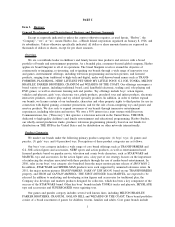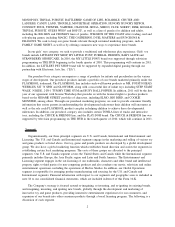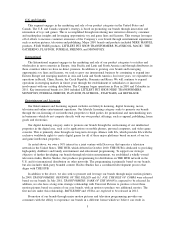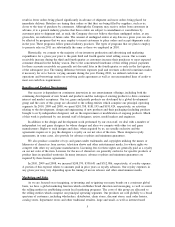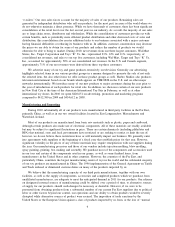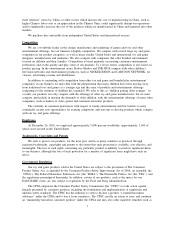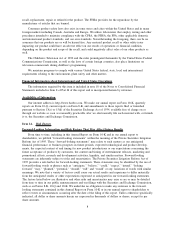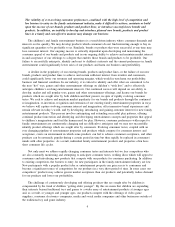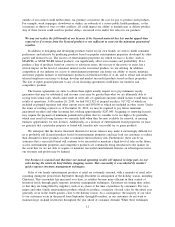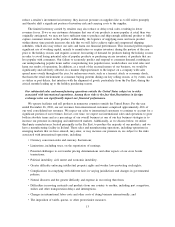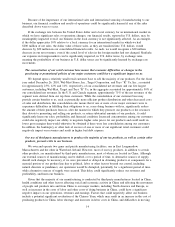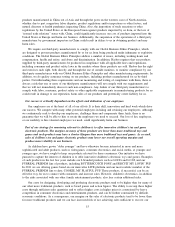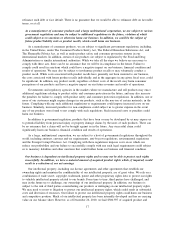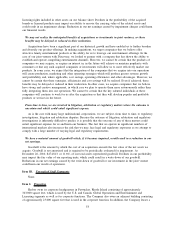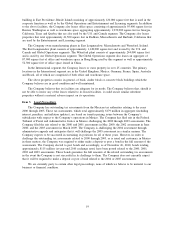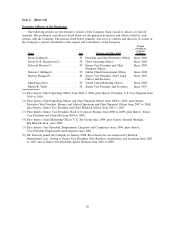Hasbro 2010 Annual Report Download - page 21
Download and view the complete annual report
Please find page 21 of the 2010 Hasbro annual report below. You can navigate through the pages in the report by either clicking on the pages listed below, or by using the keyword search tool below to find specific information within the annual report.significantly harm our business. Similarly, our business could be harmed by greater than expected costs, or
unexpected delays or difficulties, associated with the development of Hasbro Studios programming. During
2010 the Company incurred $52,047 for programming developed by Hasbro Studios and anticipates that it will
continue spending at increased levels in 2011 and future years.
At December 26, 2010, $354,612, or 8.7%, of our total assets represented our investment in THE HUB. If
THE HUB does not achieve success, or there are subsequent declines in the success or profitability of the
channel, then our investment may become impaired, which could result in a write-down through net earnings.
Economic downturns which negatively impact the retail and credit markets, or which otherwise damage
the financial health of our retail customers and consumers, can harm our business and financial
performance.
The success of our family entertainment products and our financial performance is dependent on
consumer purchases of our products. Consumers may not purchase our products because the products do not
capture consumer interest and imagination, or because competitor family entertainment offerings are deemed
more attractive. But consumer spending on our products can also be harmed by factors that negatively impact
consumers’ budgets generally, and which are not due to our product offerings.
Recessions and other economic downturns, or disruptions in credit markets, in the markets in which we
operate can result in lower levels of economic activity, lower employment levels, less consumer disposable
income, and lower consumer confidence. Similarly, reductions in the value of key assets held by consumers,
such as their homes or stock market investments, can lower consumer confidence and consumer spending
power. Any of these factors can reduce the amount which consumers spend on the purchase of our products.
This in turn can reduce our revenues and harm our financial performance and profitability.
In addition to experiencing potentially lower revenues from our products during times of economic
difficulty, in an effort to maintain sales during such times we may need to reduce the price of our products,
increase our promotional spending, or take other steps to encourage retailer and consumer purchase of our
products. Those steps may lower our net revenues, decrease our operating margins, increase our costs and/or
lower our profitability.
Other economic and public health conditions in the markets in which we operate, including rising
commodity and fuel prices, higher labor costs, increased transportation costs, outbreaks of public health
pandemics or other diseases, or third party conduct could negatively impact our ability to produce and
ship our products, and lower our revenues, margins and profitability.
Various economic and public health conditions can impact our ability to manufacture and deliver products
in a timely and cost-effective manner, or can otherwise have a significant negative impact on our business.
Significant increases in the costs of other products which are required by consumers, such as gasoline,
home heating fuels, or groceries, may reduce household spending on the discretionary entertainment products
we offer. As we discussed above, weakened economic conditions, lowered employment levels or recessions in
any of our major markets may significantly reduce consumer purchases of our products. Economic conditions
may also be negatively impacted by terrorist attacks, wars and other conflicts, increases in critical commodity
prices, or the prospect of such events. Such a weakened economic and business climate, as well as consumer
uncertainty created by such a climate, could harm our revenues and profitability.
Our success and profitability not only depend on consumer demand for our products, but also on our
ability to produce and sell those products at costs which allow for us to make a profit. Rising fuel and raw
material prices, for paperboard and other components such as resin used in plastics or electronic components,
increased transportation costs, and increased labor costs in the markets in which our products are manufactured
all may increase the costs we incur to produce and transport our products, which in turn may reduce our
margins, reduce our profitability and harm our business.
Other conditions, such as the unavailability of sufficient quantities of electrical components, may impede
our ability to manufacture, source and ship new and continuing products on a timely basis. Additional factors
11


